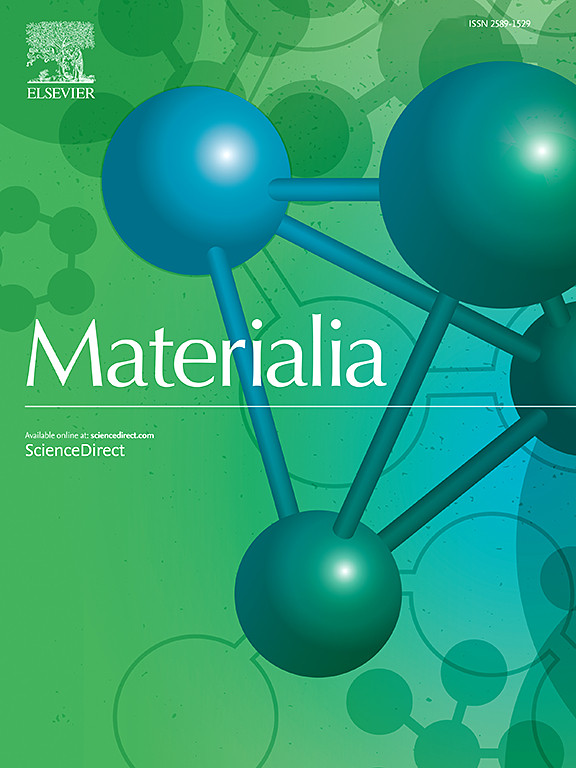Compression properties, in vitro degradation behavior and biocompatibility of porous Mg-1Zn-1Ca-0.5Mn scaffolds with different pore structures
IF 2.9
Q2 MATERIALS SCIENCE, MULTIDISCIPLINARY
引用次数: 0
Abstract
The pore shape and connectivity of porous Mg alloy scaffolds are of crucial significance for their mechanical properties, degradability, and biocompatibility. In this study, porous Mg-1Zn-1Ca-0.5Mn scaffolds with different pore structures were designed and manufactured using negative salt templates and infiltration casting to compare their properties. The results show that in terms of mechanical properties, the yield strength of the porous spherical scaffold, reaching 13.5 MPa, is higher than that of the porous cubic scaffold (4.9 MPa). Regarding degradability, the corrosion rate of the spherical scaffold (0.69±0.09 mm/year) is lower than cubic scaffold (1.09±0.12 mm/year), For biocompatibility, the pore structure of the porous spherical scaffold shows better cell adhesion compared to the cubic scaffold. The better mechanical property of the spherical scaffold can be attributed to the unique connectivity of its spherical pore structure, which enables more efficient stress dispersion, thus strengthening the overall mechanical strength. The better corrosion resistance is because the spherical scaffold has the more uniform pores and less contact area with the HBSS. As for biocompatibility, the uniform curvature of the spherical pore edges minimizes stress concentration, creating a stable mechanical environment for cells. The spherical shape closely aligns with the natural morphology of cells, which may promote cell spread and migration. Also, the continuous edges and absence of sharp corners in spherical pores reduce the mechanical stress during cell adhesion and have certain effects on enhancing cell adhesion and proliferation.

不同孔结构Mg-1Zn-1Ca-0.5Mn多孔支架的压缩性能、体外降解行为及生物相容性
多孔镁合金支架的孔隙形态和连通性对其力学性能、可降解性和生物相容性具有重要意义。本研究采用负盐模板法和渗铸法制备了不同孔隙结构的Mg-1Zn-1Ca-0.5Mn多孔支架,比较其性能。结果表明:在力学性能方面,多孔球形支架的屈服强度达到13.5 MPa,高于多孔立方支架(4.9 MPa);在可降解性方面,球形支架的腐蚀速率(0.69±0.09 mm/年)低于立方支架(1.09±0.12 mm/年);在生物相容性方面,多孔球形支架的孔结构比立方支架具有更好的细胞粘附性。球形支架具有较好的力学性能,其球形孔隙结构具有独特的连通性,使应力更有效地分散,从而增强了整体机械强度。球形支架具有更均匀的孔隙,与HBSS的接触面积更小,因此具有更好的耐蚀性。在生物相容性方面,球形孔边缘的均匀曲率最大限度地减少了应力集中,为细胞创造了稳定的机械环境。其球形与细胞的自然形态密切相关,有利于细胞的扩散和迁移。同时,球形孔的连续边缘和无尖角减少了细胞粘附过程中的机械应力,对细胞的粘附和增殖有一定的促进作用。
本文章由计算机程序翻译,如有差异,请以英文原文为准。
求助全文
约1分钟内获得全文
求助全文
来源期刊

Materialia
MATERIALS SCIENCE, MULTIDISCIPLINARY-
CiteScore
6.40
自引率
2.90%
发文量
345
审稿时长
36 days
期刊介绍:
Materialia is a multidisciplinary journal of materials science and engineering that publishes original peer-reviewed research articles. Articles in Materialia advance the understanding of the relationship between processing, structure, property, and function of materials.
Materialia publishes full-length research articles, review articles, and letters (short communications). In addition to receiving direct submissions, Materialia also accepts transfers from Acta Materialia, Inc. partner journals. Materialia offers authors the choice to publish on an open access model (with author fee), or on a subscription model (with no author fee).
 求助内容:
求助内容: 应助结果提醒方式:
应助结果提醒方式:


